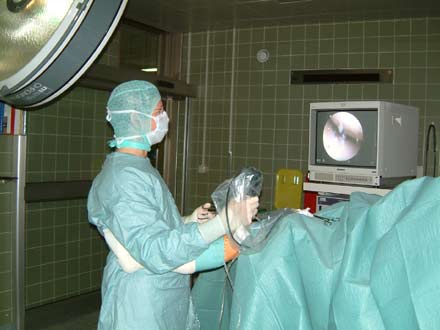Joint preservation or joint replacement?
Possibilities of Arthroscopy
Despite improved techniques in endoprosthetics, the "artificial joint" should only be implanted after all joint-preserving options have been exhausted. After all, after an artificial joint replacement, there is no way back to your own joint.
On the other hand, it is difficult to persuade patients with advanced joint destruction to forego this option when modern joint replacement techniques enable, but do not guarantee, excellent functional results after surgery.
What does “joint-preserving therapy” mean?
What surgical and conservative options are available?
Which patients is a joint replacement recommended for?
As the name suggests, your own joint should be retained. Since cartilage itself is hardly capable of regeneration, the extent of the cartilage destruction also determines the possible forms of therapy.
In the case of low to moderate cartilage destruction, improvement of the biomechanical load and cartilage surgical measures can help.
Improvement of the load situation of a joint
This is possible on the one hand by improving the stability of the joints and on the other hand by correcting the leg axis.
The easiest way to do this would of course be weight loss.
If the leg axis, leg length and rotation are incorrect, these can be corrected.
With computer support, this is possible to the exact degree.
To do this, however, the bone must be severed and also grow back together in the corrected position. The period in between lasts weeks and is associated with many restrictions for the patient.
In the ideal case, the development of osteoarthritis and thus joint replacement surgery can be completely prevented.
In practice (depending on the previous damage) this means postponing the joint replacement for about 5 to 10 years.
Joint stability
If the ligaments or the menisci of the knee joint are torn, the joint is no longer stable, and more shear forces mean greater wear and tear on the cartilage.
Meniscus preservation by suturing the meniscus should be preferred to removing parts of the meniscus, but this is not always possible. The attempt to preserve a meniscus by suturing means longer sick leave for the patient and sometimes ends in partial removal, as healing does not always take place.
Every (partial) meniscus removal disturbs the joint mechanics and leads to premature wear. Meniscal sutures are most promising when torn cruciate ligaments are reconstructed at the same time.
The anterior cruciform ligament reconstruction on the knee joint stabilizes the joint and thereby also protects the cartilage from damaging shear forces. Not every torn cruciate ligament requires surgical treatment. If instability problems and meniscus damage occur, ligament reconstruction should no longer be delayed. This is performed arthroscopically in a short inpatient stay.
Cartilage surgery
Knee pain with already moderate cartilage damage can often be significantly improved as a result.
The success of cartilage surgery depends on the one hand on the extent of the cartilage destruction and on the other hand on the biomechanical requirements. Correct leg axis and a stable joint are the prerequisites for this. Hyaline joint cartilage is hardly capable of regeneration. Smaller defects can be filled with fiber cartilage in the sense of defect healing. This can be surgically stimulated using the microfracture technique. The bone under the defect is punctured using special instruments. This stimulates tissue formation.
The only way to bring real hyaline cartilage back into a defect is through cartilage transplantation. In the technique of mosaic plastic, cartilage and bone cylinders are punched out of less stressed regions and inserted into the defect. This can be used to restore areas of up to a few square centimeters. This procedure is relatively demanding, but gives very good results when correctly indicated.
The technique of cartilage cell cultivation is also suitable for approximately the same defect sizes. Cartilage tissue is surgically removed from the joint, grown and re-implanted in the defect in a further procedure. Although this process is likely to have a future, there are currently some serious drawbacks. Two interventions are required and the resulting cartilage is not true hyaline cartilage. Besides, the price of cartilage cell cultivation is relatively high. Advantage is the relatively simple surgical technique.
It is to be hoped that improved three-dimensional tissue cultivation will make it possible to obtain real hyaline cartilage.
Lifestyle
Joint-preserving therapy naturally begins, as already mentioned, with weight, muscular training condition and diet. Acidification with increased uric acid levels in particular affects cartilage nutrition and resilience. The simplest prophylaxis can be managed by the patient himself with a sensible diet and exercise.

